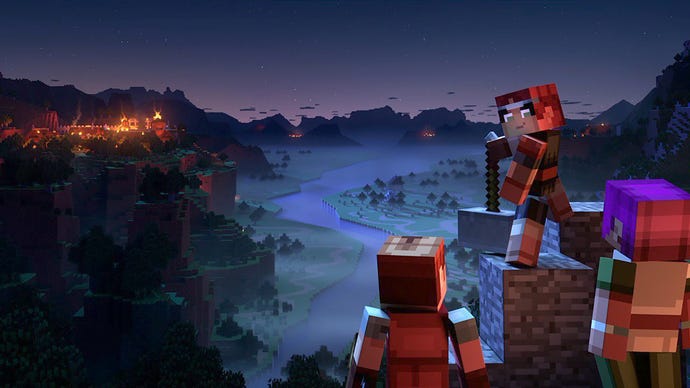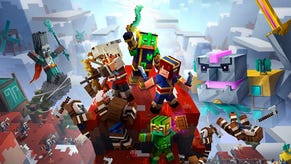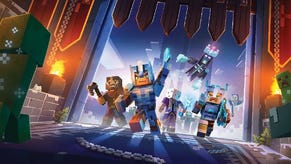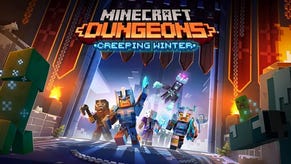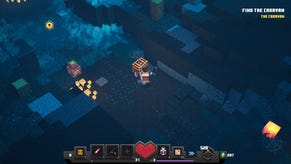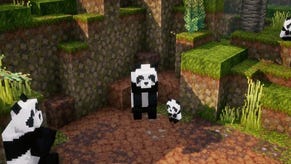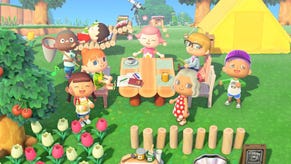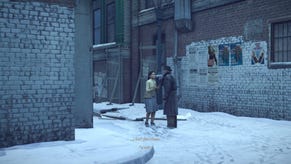Inside Minecraft Dungeon's Journey From a Zelda-Inspired 3DS Game to an Approachable Dungeon Crawler
Mojang prepares to deliver its first spinoff for the multi-million best-seller Minecraft.
This article first appeared on USgamer, a partner publication of VG247. Some content, such as this article, has been migrated to VG247 for posterity after USgamer's closure - but it has not been edited or further vetted by the VG247 team.
Mojang and parent company Microsoft are only beginning to scratch the surface of what Minecraft could become. Nine years after its original full release, Minecraft has had few releases outside of the primary game. Minecraft: Story Mode was developed and published by Telltale Games, and Minecraft Earth, a mobile-focused augmented reality game, is still in early access. With 176 million copies sold worldwide, you'd think Minecraft would be a booming extended franchise by now. That's changing this year, as Mojang is preparing to release the first proper spinoff developed by the Minecraft studio: Minecraft Dungeons.
Minecraft Dungeons takes the familiar Minecraft aesthetic and applies it to an overhead dungeon-crawler, like a more family-friendly version of Blizzard Entertainment's Diablo series. You can dive into a Creeper and Zombie killing frenzy alone, or with up to four players. It doubles as one of the biggest projects to come from Mojang outside of Minecraft. It's very possible that you've never heard of Mojang's other games, like Caller's Bane (formerly Scrolls), or Crown and Council. In contrast, Minecraft Dungeons is one of Xbox Game Studios' key titles this year. Hell, it's one of the biggest games releasing this month.
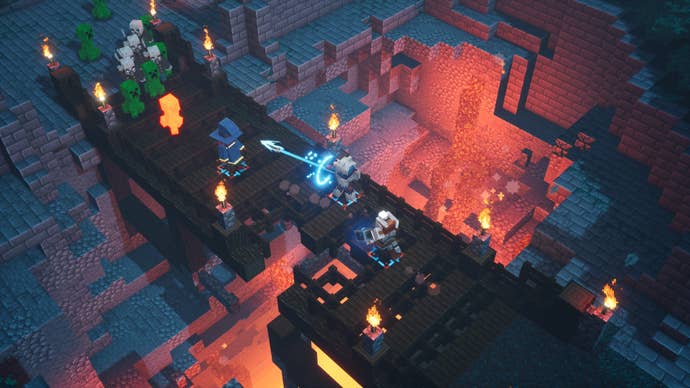
Enter The Dungeon
Minecraft Dungeons is the work of a small team within Mojang dedicated to crafting something new for the franchise. It's primarily the work of Mojang's Stockholm team, with British developer Double Eleven helping with multiplayer and console ports, and a QA team. "In the Stockholm office, we were about seven people when we started," says Minecraft Dungeons game director Måns Olson. "We're approaching 20 to 25 now, maybe something like that. Then there's a couple folks in Redmond, and we have some quality assurance in the U.K. and Poland. But yeah, it isn't a very big thing."
Olson is leading the team, but he contends that the project was never the work of one individual. Instead it started from the Mojang team wondering where else Minecraft could potentially go. The main game is quite broad in terms of the experiences that players can have with it, so for the project that became Dungeons, Mojang wanted something more specific.
"We wanted to bring a new Minecraft experience to players. To make a new game that was something that you couldn't get in vanilla Minecraft," says Olson. "To make something new, you have to step quite far away from the base game."
The original effort was a dungeon-crawler inspired by Nintendo's The Legend of Zelda series (and Dark Souls), though Olson acknowledges that "not as much of that has made it through into the game as it is today."

"It started as a small single-player game, smaller in scope, and as we started prototyping we realized it would be fun to play multiplayer," says Olson. "Originally this was considered as a 3DS game, but then we realized we wanted to have it on the Switch, PlayStation, Xbox Game Pass, and Windows."
Once the team decided on a multiplayer title, development iteration saw the game changing from one that was inspired by Zelda to one rooted in PC dungeon crawlers. "If you look at inspirations now, it's closer in terms of gameplay to games like Diablo, Torchlight, and Gauntlet," Olson adds. "And also the cooperative experience is pulling a lot from modern first-person shooter cooperative games like Left 4 Dead and [Warhammer: End Times - Vermintide]. So absolutely there's been things that have been either implemented and then changed, or designed on paper, but that never made it into the game."
Minecraft Dungeons plays similar to the console ports of Diablo 3 or Torchlight. Up to four players can dive into several regions of the Minecraft universe, all procedurally-generated into different configurations. The barriers to entry are light, with drop-in, drop-out cooperative play. Minecraft appeals to a broad cross-section of folks, and Mojang wants that to carry over to Minecraft Dungeons.
One thing that's missing that's decidedly "Minecraft" is any sort of building or crafting. You can't even destroy blocks in the environment. Outside of the look, it's almost as if the team has stripped away the bedrock of Minecraft for Dungeons. That was a specific choice by the developers, to anchor players in a new experience.
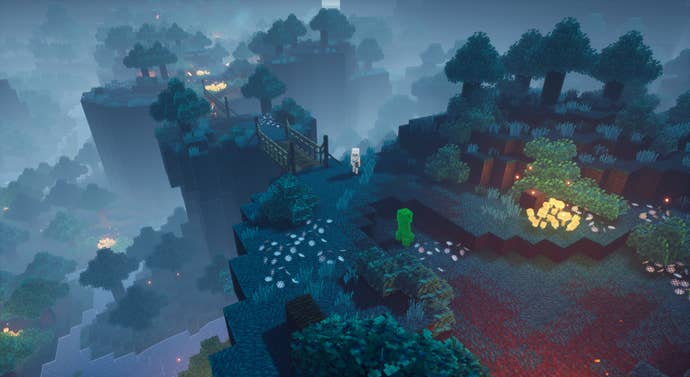
"[Building and crafting were] on the table and it was a choice specifically to leave those things out. We want to give players a great experience in the areas that we chose to focus on and we don't really want to give players a subpar crafting or building experience that's just kind of what you do in Minecraft, but not great," Olson says. "We've been very careful to make sure that we don't have any destructible blocks in the world. We do that so that we set expectations early on: this isn't the world that you can change."
Olson says that the team did play around with the idea of allowing some blocks to be destroyed in order to uncover hidden paths, but decided against the implementation. They also weren't worried about turning off too many Minecraft players, because that game's Adventure Mode operates in much the same way. The key was making a game that's not Minecraft, but still feels very Minecraft.
The development of Minecraft Dungeons also changed aspects of the original Minecraft. The Illager faction of hostile mobs was added to Minecraft in 2019, but the idea actually started in Dungeons. The latter title actually has a narrative to its campaign, and the Dungeons team needed an enemy faction for that purpose. Mojang chief creative officer Jens Bergensten created the faction for Dungeons and then ended up using them in Minecraft.
"The whole faction was invented as a way to put in lots of different enemies with different personalities and traits," says Olson. "They're an example of something that was added to Dungeons first, but that is now in the vanilla game as well. Dungeons has narrative, which vanilla Minecraft does not—at least not to these to the same extent. We've had to come up with things that will work as a narrative foundation for Minecraft Dungeons."
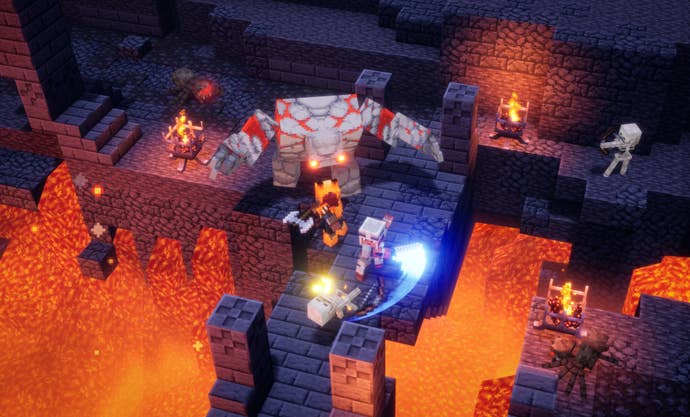
A Dark and Stormy Night
Minecraft is a game that runs on everything under the sun, and Mojang has been supporting the Bedrock Edition for a long time. That means it can't rely wholly on the latest computer graphics technology. Minecraft's limitations proved to be an opportunity for Minecraft Dungeons: Unhindered by older technology, the visual aesthetic of Minecraft Dungeons is able to immediately differentiate itself from its predecessor. The blocky foundations are the same, but Dungeons is host to impressive bloom lighting and fog. Lava and torches glow in the darkness, and Creepers wander out of the misty forest. The only time vanilla Minecraft has looked this good is with several mods, or the recently-released Minecraft RTX edition.
Dungeons is built on Unreal Engine 4, meaning a lot of those visual bells and whistles are just baked in. The decision to use Unreal Engine was made early on according to Olson, as Unreal allowed Mojang to move at "a quick pace with a small team."
"We're using a different engine, so we have all these tools that can give you dynamic lights, fog, blooms, and glows," says Minecraft Dungeons art director Daniel Björkefors. "We knew early on that we needed that for the 'RPG' sense of the game. It's not as dark and terrifying as Diablo for example, but you still need that fantasy, adventurous look. With Unreal you get that pretty much for free. I wouldn't say it for free, but it's not that hard to make it look as it does, compared to vanilla, which is struggling with that kind of polished look."
Other additions to Minecraft Dungeons include edge highlights, which help players see their targets in a mess of enemies. Björkefors is also the UX/UI designer for Minecraft Dungeons. The final UI of the game still evokes the blocky nature of Minecraft, but it's far smoother and more polished compared to Minecaft's utilitarian user interface. Olson notes that the user interface is "one of the areas where we've deviated most."
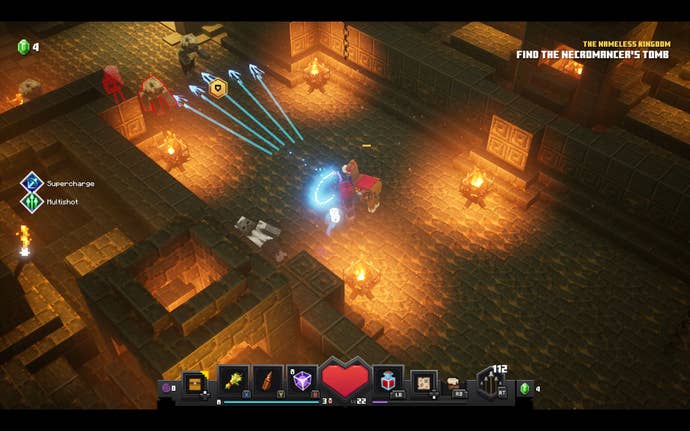

Part of the success of Minecraft comes from creative expression: players can do almost anything in the game, from making a small hut to working computers, to detailed recreations of fictional pop culture landmarks. In contrast, the focus of Minecraft Dungeons means most of your creative outlet will come from how you build your character. Gameplay comes first, and your weapons, armor, and skills are the primary way to differentiate yourself.
"You are what you wear, so you're constantly changing your character depending on what you choose to wear and the battle style you want," says Björkefors when I ask about potential creative outlets for players.
Olson agrees, noting that's always been key for Dungeons, even early in development. "That's been our big focus. We have this idea that you are what you wear, and that your character is your sandbox," he explains. "We don't have any character classes. How you customize both your playstyle and your appearance with the gear and how that synergizes with the random enchantments that you can find on gear, that's kind of the key creative aspect in Minecraft Dungeons."
Olson also says that Minecraft Dungeons is designed around the "idea of constantly challenging you to change your gear." You might find a bow that fits with your skills and feels overpowered, but moving to a different region or even just increasing the difficulty forces you to try something different. The team doesn't want players to focus on one weapon for the entire campaign. "That's been in the game from the start," he says.
The core tenets of Minecraft Dungeons also don't leave much room for other creative outlets, since players won't be able to build their own levels—at least, not at launch. "I wouldn't say it's not a part of the Dungeons' concept as much as we wanted to have a narrow focus, to make sure that we do a few things as well as we possibly can," he tells USG. "So it's not something that we have planned at the moment, but that's not the same thing as saying we will never do it. Obviously, we'll launch the game and see how players react and then think about how we expand from there."
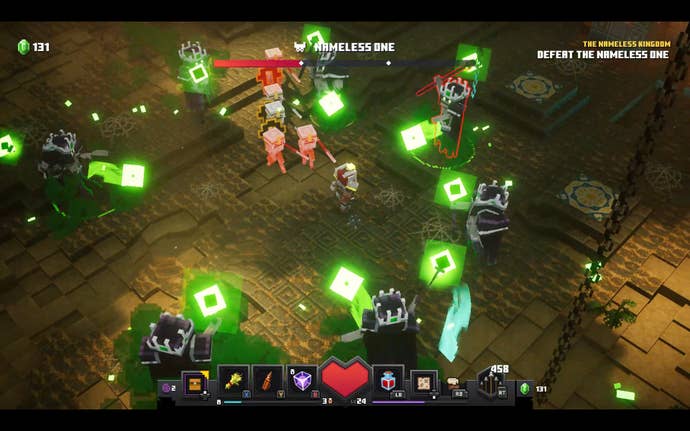
Torch in Hand
Minecraft Dungeons represents a future for Minecraft where there's far more variety, even beyond the broad reach of classic Minecraft. One day, perhaps, an entire family of games can exist around the blocky survival building game, with Minecraft, Minecraft Earth, and Minecraft Dungeons being just the starting lineup. Minecraft Dungeons is planned to launch on May 26 on Nintendo Switch, PlayStation 4, Windows, Xbox One, and Xbox Game Pass. After launch, the team already has two DLC releases planned, which will take players to new areas beyond the narrative campaign. "I guess I can say it's biomes, since all the levels are different biomes basically. But yeah, we have fun stuff," says Björkefors.
The team is also in the planning phases for future updates past that, assuming players love and support Minecraft Dungeons.
Minecraft is a game that's everywhere, with one of the longest tails in the industry. The team behind its spinoff is hoping that Minecraft Dungeons will last just as long. From its humble beginnings as a small 3DS adventure, to being the next big release from the studio behind Minecraft, Olson acknowledges that his team of 25 is taking a big step for the company.
"It's fun and daunting. You know, it's a big responsibility," he says. "We know we have a super passionate community that really loves this game as much as we do and that have high expectations of what it needs to be. We're never gonna match everyone's expectations completely. Originally, that was super scary. Now we feel like we have something that players like, which is a great feeling."
